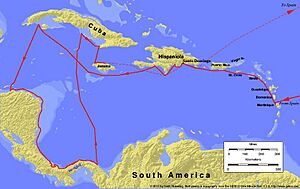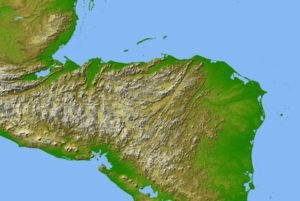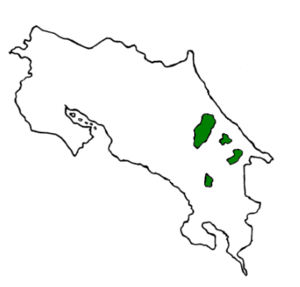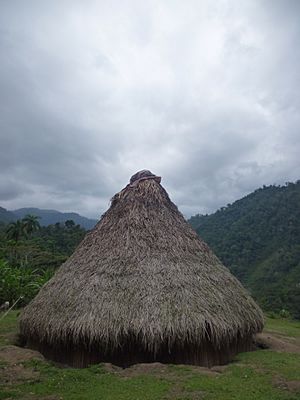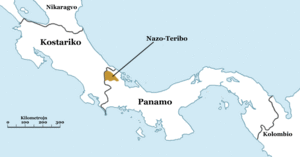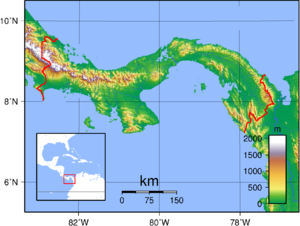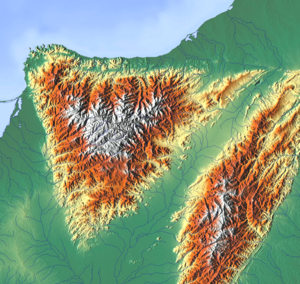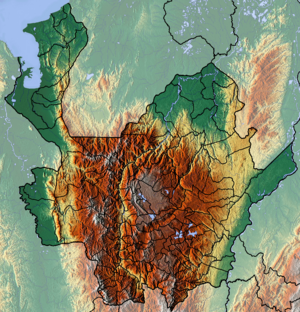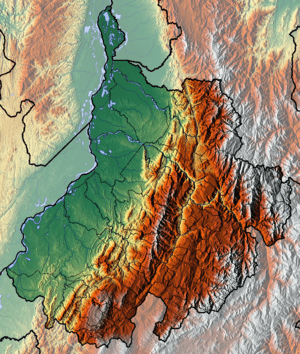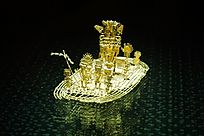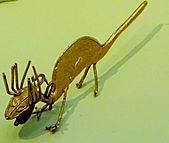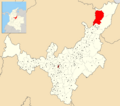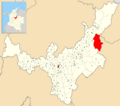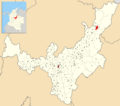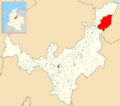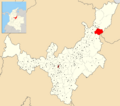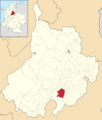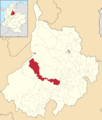Spanish conquest of the Chibchan nations facts for kids
The Spanish conquest of the Chibchan nations was when the Spanish monarchy took control of lands where Chibcha language-speaking people lived. These groups, mainly the Muisca and Tairona, lived in what is now Colombia. This conquest marked the beginning of the Spanish colonization of the Americas.
Contents
Ancient People of Colombia
Long ago, the first people in Colombia came from Mesoamerica (Central America). They arrived in waves, starting around 1200 BC. Later, groups called Arawaks came from southern South America. Then, the Caribs, who were known for fighting, settled in the lower lands. They pushed the earlier groups into the mountains. Parts of southern Colombia were also once part of the Inca Empire.
When the Spanish arrived, two main tribes were very well-developed: the Muisca and the Tairona. Both of these groups were part of the larger Chibchan family.
By the 1500s, the Chibchas were mainly in two places:
- The Muisca lived on the high plateaus of Cundinamarca and Boyacá.
- The Tairona lived along the northern mountains of the Sierra Nevada de Santa Marta.
Spanish Arrival and Conquest
The Spanish first saw the territory of Colombia in 1499 with explorer Alonso de Ojeda, but he didn't land. Soon after, Juan de la Cosa landed at Cabo de la Vela (Cape of Sails).
In 1502, Spanish explorers led by Vasco Núñez de Balboa explored the area near the Atrato River. They founded Santa María la Antigua del Darién around 1509. This was one of the first European settlements on the mainland of the Americas.
On July 29, 1525, the city of Santa Marta was founded on Colombia's northern coast by Rodrigo de Bastidas.
Conquering the Muisca
In April 1536, the Spanish leader Gonzalo Jiménez de Quesada led a large group into the Andes mountains. This was where the powerful Muisca Confederation was located. He had about 800 Spanish soldiers and 85 horses.
Near the towns of Suesca and Nemocón, the Muisca tried to fight back in March 1537. The Muisca leader, zipa Tisquesusa, tried to push out the invaders. But the Spanish showed how strong their weapons were.
In April of that year, Tisquesusa's people kept attacking De Quesada on the Bogotá savanna. However, De Quesada used the rivalries between different Muisca chiefs to weaken the zipa of Bacatá. Chiefs from Chía and Suba were among the first to join the Spanish. Tisquesusa's men kept losing battles because the Spanish had horses, dogs, and firearms. Tisquesusa continued to fight, but he died in a small battle in late 1537. The Spanish didn't even know he had died right away, nor did they find his hidden treasure.
Tisquesusa's nephew, Sagipa, became the new leader and soon surrendered to the Spanish. But relations quickly worsened. The Spanish wanted to find the lost treasure. They arrested Sagipa, accusing him of rebelling and refusing to say where the treasure was hidden.
Another Muisca chief, Tundama, was ready to fight. He gathered his people and asked for help from nearby chiefs. When Hernán Pérez de Quesada, Gonzalo's brother, arrived, he found the Muisca troops well-organized and decorated with colorful feathers. In this battle, called the Battle of Bonza, the Muisca fought bravely. Hernán de Quesada almost died when he fell from his horse, but the Spanish eventually won.
Finally, on August 6, 1538, the city of Bogotá was founded. It was first called Santa Fé de Bogotá and was built on the remains of the Muisca capital, Bacatá.
Other Chibchan Groups
Besides the Muisca and Tairona, many other Chibcha-speaking groups lived across Central and South America.
Northern Chibcha Groups
Pech People
The Pech are an indigenous group in northeastern Honduras. They were once known as the Paya. By 2005, their population was about 3,800. The Pech language is part of the Chibchan language family. Older people still speak it, but it is in danger of disappearing. The Pech developed complex societies as early as 300 CE. They may have developed on their own or been influenced by the nearby Maya. When the Spanish arrived in the 1500s, powerful chiefdoms controlled the coastal areas.
The Pech suffered greatly from attacks by the Miskito people, who allied with British traders and runaway slaves. These attacks forced the Pech to move into the mountains, away from the coast.
Rama People
The Rama people are descendants of indigenous communities who lived on the Caribbean coast of Nicaragua. After the Spanish arrived, British pirates teamed up with the Miskito. The Miskito helped the British fight the Spanish in exchange for guns. This allowed the Miskito to control other indigenous groups like the Rama. According to Rama stories, the Miskito gave them the island of Rama Cay in the 1700s for helping them fight the Teribe people of Costa Rica.
In the 1900s, the Rama and other indigenous groups relied on private businesses for their economy. In the 1980s, the Sandinista government tried to take over all private businesses. This reduced private investment on the Caribbean coast. Many indigenous groups, including the Rama, did not like this interference. They joined the Contras, a group fighting the Sandinista government. The Nicaraguan Revolution caused many Rama to lose their homes and traditional lands.
Boruca People
The Boruca are a tribe from Southern Pacific Costa Rica, near the Panama border. The tribe is a mix of the original Boruca people and other groups like the Coto and Quepos.
Today, there are about 2,000 Boruca people. Most live on the Reserva Boruca or the nearby Reserva Rey Curre. These were among the first indigenous reserves in Costa Rica, set up in 1956. Laws in Costa Rica protect these lands as the property of indigenous people. The Indigenous Law of Costa Rica (1977) set out the basic rights of indigenous peoples. It said that the reserves would govern themselves and limited how land could be used within them.
Talamanca Region Groups
Cabécar People
The Cabécar are an indigenous group from the remote Talamanca region of eastern Costa Rica. They speak Cabécar, a language from the Chibchan family. They are the largest indigenous group in Costa Rica, with nearly 17,000 people.
Scientists have debated where the Chibchan languages came from. One idea is that they started in Colombia and spread north. But other evidence, like archaeological findings and language studies, suggests that Chibchan languages developed in the Talamanca mountain range in Costa Rica and Panama. From there, Chibchan-speaking groups moved and settled as far north as Honduras and as far south as Colombia.
Bribri People
The Bribri were the original people of the Talamanca region. They lived in the mountains and Caribbean coastal areas of Costa Rica and northern Panama. Most Bribri today have running water and some electricity. They grow cacao, bananas, and plantains to sell. They also grow beans, rice, corn, and other foods for themselves.
Many Bribri live in isolated areas and have their own language. This has helped them keep their culture alive. However, it also means they have less access to education and healthcare. Even though they have low incomes, they grow much of their own food, medicine, and building materials. They earn money by selling cacao, bananas, and plantains, and through tourism, to buy things they cannot grow.
Naso People
The Naso (also called Teribe or Térraba) people have traditionally lived in the mountainous jungle regions of western Bocas del Toro in Panama. They identify strongly with the lands along the Teribe River. For a long time, the Naso people lived very independently. They were spread out in clans and homesteads and were geographically isolated. This allowed them to develop their culture through family traditions.
Panama and Colombia Groups
Ngäbe People
The Ngäbe or Guaymí people are an indigenous group living mainly in the Ngäbe-Buglé comarca in western Panama. They also have five indigenous territories in southwestern Costa Rica. There are about 200,000 to 250,000 people who speak Ngäbere today.
Guaymí is an old name for them. The Ngäbe call themselves Ngäbe, which means "people" in their language. Many Ngäbe have moved to Costa Rica to find work on coffee farms. Ngäbere and Buglere are different languages in the Chibchan family. They cannot understand each other.
Bokota People
The Bokota people, also called Bogotá or Buglere, are an Amerindian group in Panama. They live in Bocas del Toro and northern Veraguas. They live in the same region as the Teribe or Naso Indians.
In 2000, there were 993 Bokota living in Panama. They are the smallest tribe in Panama.
Sierra Nevada de Santa Marta Groups
Tairona People
The Tairona lived in the northern and central parts of the isolated Sierra Nevada de Santa Marta mountain range. They were divided into two groups: the coastal Tairona by the Caribbean sea, and the mountain Tairona in the higher cloud forests. The lowland Tairona fished and made salt. They traded salt for cotton cloth and blankets with the Muisca and other nearby groups. Both Tairona groups lived in many small, well-organized towns connected by stone roads.
Arhuaco People
The Arhuacos live in the upper valleys of several rivers in the Sierra Nevada de Santa Marta. Their traditional territory before the Spanish colonization was much larger. It included many sacred sites they still visit today. These lost territories are the lower parts of the mountains, which were taken over by settlers and farmers.
Other Colombian Chibcha Groups
Kuna People
The Kuna people were encountered by explorers like Columbus in 1502. They lived in areas that are now part of Colombia and Panama.
Nutabe People
The Nutabe traded with neighboring tribes, using a special bridge over the San Andreas River. Their society was made up of small, independent chiefdoms. But when the Spanish conquistadors arrived, these tribes often worked together to defend their lands. The Nutabe were generally peaceful, but they fought to protect their territory from the Spanish. Their leader at the time was a chief named Guarcama.
Motilon People
The Motilon people were encountered by Spanish conquistadors like Ambrosius Ehinger and Nikolaus Federmann in the 1530s.
U'wa People
The U'wa people were encountered by conquistadors like Nikolaus Federmann and Miguel Holguín y Figueroa in the late 1530s.
Lache People
The Lache people were also encountered by Nikolaus Federmann and Miguel Holguín y Figueroa in the late 1530s, and later by Hernán Pérez de Quesada.
Guane People
The Guane people lived in the Santander region. The Spanish founded towns in their territory, such as Vélez in 1539 and Oiba in 1540.
Muisca Civilization Details
| Feb 1537 | First contact @ Chipatá | |||
| Mar-Apr 1537 | Expedition into Muisca Confederation | |||
| 20 Apr 1537 | Conquest of Funza upon zipa Tisquesusa | |||
| May-Aug 1537 | Expedition & conquest in Tenza Valley | |||
| 20 Aug 1537 | Conquest Hunza, zaque Quemuenchatocha | |||
| Early Sep 1537 | Conquest Sugamuxi, iraca Sugamuxi | |||
| Oct 1537-Feb 1538 | Other foundations on Altiplano & valleys | |||
| 6 Aug 1538 | Foundation Santafé de Bogotá, by Gonzalo | |||
| 20 Aug 1538 | B. of Tocarema; Spanish & zipa beat Panche | |||
| 6 Aug 1539 | Foundation Tunja, by Gonzalo Suárez | |||
| 15 Dec 1539 | Conquest Tundama, by Baltasar Maldonado | |||
| Early 1540 | Decapitation last zaque Aquiminzaque, Hernán | |||
| The Muisca established on the Altiplano Cundiboyacense one of the four grand civilisations of the pre-Columbian Americas | ||||
| El Dorado | Sun Temple | tunjo | El Infiernito | |
| Their southwestern neighbours, inhabiting the highest parts under páramo conditions; the Sutagao were the southernmost Chibcha speakers | ||||
The Muisca people lived on a high plateau in the Andes mountains of Colombia. They were an advanced civilization of farmers and traders.
Unlike the Maya, Aztec, and Inca, the Muisca did not build with stone. Their houses, temples, and shrines were made from wood and clay. They were known as "Salt People" because they mined halite (salt) from places like Zipaquirá.
The Muisca believed in many gods. Their religion and mythology were closely linked to nature. They understood astronomy well and had a complex luni-solar calendar. This calendar helped them know when to plant, harvest, and hold festivals. During festivals, they sang, danced, played music, and drank a lot of their traditional drink, chicha.
The most respected members of the Muisca community were mummified. Their mummies were not buried but displayed in temples or natural caves. Sometimes, they were even carried into battles to scare enemies.
Their art is the most famous part of their culture today. The Spanish destroyed many of their living spaces and temples. A great example of their gold work is the Muisca raft. This and other items made of gold, tumbaga (a gold alloy), ceramics, and cotton are shown at the Museo del Oro in Bogotá.
The Muisca were mainly farmers. They had small farms but also traded a lot. They exchanged blankets, gold, emeralds, and salt for fruits, vegetables, coca, yopo, and cotton. These items came from warmer lands where their neighbors lived. They also traded with groups farther away, like the Calima and Pijao.
The Muisca used a decimal counting system, counting with their fingers. Their system went from 1 to 10. For numbers above 10, they used the word quihicha, meaning "foot." So, eleven was "foot one," twelve was "foot two," and so on. The number 20 was special because it was the total number of fingers and toes. They had two ways to say 20: "foot ten" (quihícha ubchihica) or their unique word gueta, which came from gue meaning "house." Numbers between 20 and 30 were counted as "twenty plus one" (21), "twenty plus ten" (30). Larger numbers were counted as multiples of twenty, like "20 times 2" (40) or "20 times 5" (100). The Muisca also had a system of hieroglyphs, but they only used them for numbers.
The Spanish conquest of the Muisca was very difficult. More than 80% of the Spanish soldiers and horses who started the year-long journey to the Muisca Confederation did not survive. The Spanish founded several settlements in the Muisca lands between 1537 and 1539.
Sutagao People
The Sutagao were a Chibcha-speaking indigenous group from the region of Fusagasugá, in Cundinamarca, Colombia. We know about the Sutagao from the scholar Lucas Fernández de Piedrahita.
Before the Spanish arrived, the Sutagao were fighting with the Muisca. The Muisca leader, Zipa Saguamanchica, conquered the Sutagao around 1470. Conquistador Juan de Céspedes, working for Gonzalo Jiménez de Quesada, brought the Sutagao under Spanish rule.
The Sutagao lived in the region until a new town was founded in 1592. In 1592, there were 759 indigenous people in Fusagasugá. By 1760, the indigenous population had dropped to 85, while there were 644 new settlers.
Images for kids
See also
 In Spanish: Conquista de la Nueva Granada para niños
In Spanish: Conquista de la Nueva Granada para niños
- List of conquistadors in Colombia
- Comparison Chibcha words
- Spanish conquest of the Muisca
- Spanish conquest of Honduras
- Hernán de Quesada, Juan de Céspedes
- Gonzalo de Quesada, Sebastián de Belalcázar, New Kingdom of Granada
- Non-Chibcha neighbors:



